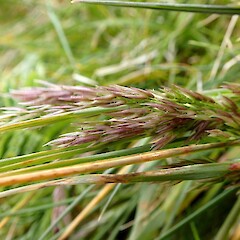Agrostis magellanica
Synonyms
Agrostis multiculmis Hook.f.
Family
Poaceae
Flora category
Vascular – Native
Endemic taxon
Yes
Endemic genus
No
Endemic family
No
Structural class
Grasses
NVS code
The National Vegetation Survey (NVS) Databank is a physical archive and electronic databank containing records of over 94,000 vegetation survey plots - including data from over 19,000 permanent plots. NVS maintains a standard set of species code abbreviations that correspond to standard scientific plant names from the Ngä Tipu o Aotearoa - New Zealand Plants database.
AGRMAG
Chromosome number
2n = 84
Current conservation status
The conservation status of all known New Zealand vascular plant taxa at the rank of species and below were reassessed in 2017 using the New Zealand Threat Classification System (NZTCS) – more information about this can be found on the NZTCS website. This report includes a statistical summary and brief notes on changes since 2012 and replaces all previous NZTCS lists for vascular plants.
Please note, threat classifications are often suggested by authors when publications fall between NZTCS assessment periods – an interim threat classification status has not been assessed by the NZTCS panel.
- Conservation status of New Zealand indigenous vascular plants, 2017 . 2018. Peter J. de Lange, Jeremy R. Rolfe, John W. Barkla, Shannel P. Courtney, Paul D. Champion, Leon R. Perrie, Sarah M. Beadel, Kerry A. Ford, Ilse Breitwieser, Ines Schönberger, Rowan Hindmarsh-Walls, Peter B. Heenan and Kate Ladley. Department of Conservation. Source: NZTCS and licensed by DOC for reuse under the Creative Commons Attribution 4.0 International licence.
2017 | Not Threatened | Qualifiers: SO
Previous conservation statuses
2012 | Not Threatened
2009 | Not Threatened
2004 | Not Threatened
Distribution
Indigenous. South Island (south-western region only), Antipodes Islands, Auckland Islands, and Campbell Island/Motu Ihupuku. Indigenous to Macquarie, Falkland, Kerguelen, Crozet and Marion Islands and South America from Chile to Tierra del Fuego
Habitat
In the South Island subalpine to alpine on rocky or stony ground. In the Subantarctic Islands at lower elevations where it grows in dry or wet peat and amongst moss cushions.
Manaaki Whenua Online Interactive Key
Life cycle
Florets are dispersed by wind and water (Thorsen et al., 2009).
Propagation technique
Easily grown from fresh seed and rooted pieces but dislikes humid conditions, and needs a cold winter to flower.
Etymology
agrostis: Greek name for a kind of grass
magellanica: Named after the Magellan Straits in southern South America
Where To Buy
Not commercially available
References and further reading
Thorsen MJ, Dickinson KJM, Seddon PJ. 2009. Seed dispersal systems in the New Zealand flora. Perspectives in Plant Ecology, Evolution and Systematics 11: 285–309.





